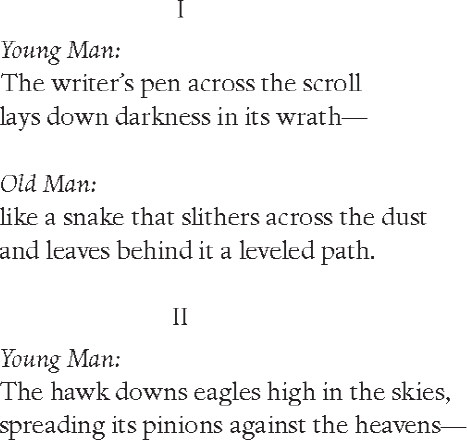YEHUDA ALHARIZI
(1165–1225)
In all of the extant documents pertaining to medieval Jewish life in Spain and the Eastern rim of the Mediterranean, there is just a single physical description of an important Hebrew poet by another writer. “A tall, silver-haired man with a smooth face” is how the Arab biographer Ibn al-Sha‘ar al-Mawsili (1197–1256) describes YEHUDA ALHARIZI, whom he refers to by his Arabic name, Yahya Ibn Suleimaan Ibn Sha’ul Abu Zakhariyya Alharizi al-Yahudi. From al-Mawsili’s short biography we also learn that Alharizi’s masterpiece, the collection of maqaamas known as Sefer Tahkemoni, was written in the East, for which the poet had set out in 1215. Alharizi is, nonetheless, an Andalusian writer through and through, though the classical Andalusian ethos seems in his writing, as Ezra Fleischer has put it, to be reflected in a warped mirror. Dictional purity, pictorial density, sophistication of form, and loyalty to Arabic literary models remain, but the high seriousness, sublimity, profundity, and lyric innocence of the classical poetry are gone. In keeping with the requirements of the maqaama, they are replaced by the elements of humor, picaresque narration, and at times a more popular register, tone, and choice of subject. While the details about the first half of his life are not quite clear, it seems that Alharizi was born in Toledo, to a family that—as his name implies—originally came from Jerez. He was educated in the Arabized Christian capital of Castile, and it appears that most of his adult life was spent in Provence, where he translated a number of important Arabic and Judeo-Arabic works, including Maimonides’ Guide for the Perplexed and part of his commentary on the Mishna. He also produced an impressive Hebrew version (or adaptation) of one of the most important maqaamas in the history of Arabic literature, al-Hariiri of Basra’s Maqaa-maat (c. 1054–1112), which the modern editor of that work called Mahberot Iti’el (The Book of Iti’el).
Driven by a combination of economic, political, and perhaps even spiritual factors, Alharizi set out for the East c. 1215, stopping in Alexandria, then taking the overland route via Fustat to Jerusalem. From there he continued on to Jewish communities in Palestine, Syria, and Iraq, transforming his impressions of the places and people he encountered into what is perhaps the greatest achievement of Hebrew literature during the Christian-Spanish period. A book of staggering verve and virtuosity, Sefer Tahkemoni artfully blends rhymed prose narratives and metrical poems to provide a hilarious and often scathing account of the communities through which he passes. Alharizi’s sharp tongue spares no one, as it passes judgment on officeholders, religious leaders, poets, pretenders, and patrons. While the author’s introduction places the work in a religio-philosophical frame, the book is overwhelmingly secular, and his subject matter ranges from nature, war, morality, and the history of the Hebrew language to erotic encounter, drunkenness, homosexuality, and fraud. (Alharizi also wrote a more straightforward account of his travels in an Arabic work called Al-rawda al-‘aniiqa—The Pleasant Garden—which reveals him to be an excellent poet in that language as well.) As an Andalusian, Alharizi had high expectations of his visit to the cradle of Arabic civilization, but he was deeply disturbed to find that Jewish life in the East was very different from what he had known in Spain and even Provence, where Hebrew literature had blossomed in the context of some two centuries of court life. Appalled at the state to which Eastern Hebrew culture had fallen, and also angered by the fact that Hebrew had not been able to produce anything original to rival the splendors of al-Hariiri’s Maqaamaat, he set out to compose Sefer Tahkemoni to redeem—he says—the language itself. The work may also reflect, Fleischer notes, a crisis in the Jewish circles of northern Spain, which were increasingly dominated by a growing class of nouveauriche Jews who had little connection to Hebrew culture and Judaism as a vital faith. In a culture defined by this essentially vulgar class of people, poetry’s place was marginal at best. Read in this light, Sefer Tahkemoni can be seen as a part of a larger battle for survival that Alharizi was waging in the face of cultural decline. Alharizi died in Aleppo, Syria, in December of 1225. The selection here is taken from the metrical poems found in various chapters of Sefer Tahkemoni.

BORN TO BASENESS

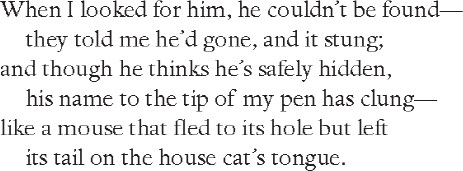
THE HYPOCRITE

THE JERK

A MISER IN MOSUL
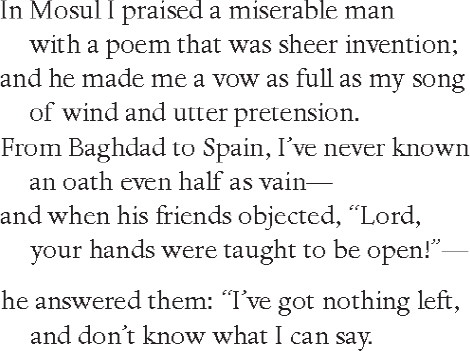

THE MISER
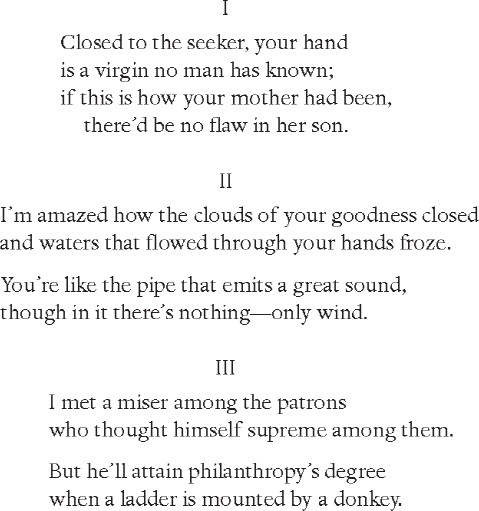
ON ZION’S HOLY HILL

BOYS: TWO POEMS
I. IF AMRAM’S SON

II. AN ANSWER
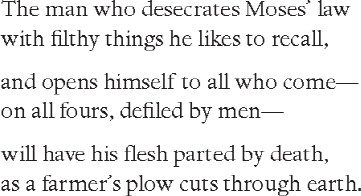
MASTERS OF SONG

MEASURE FOR MEASURE
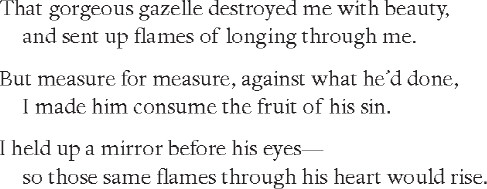
A LOVER WANDERED
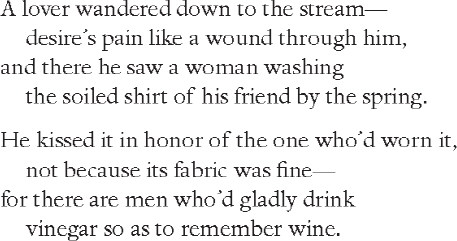
HOW LONG, MY FAWN
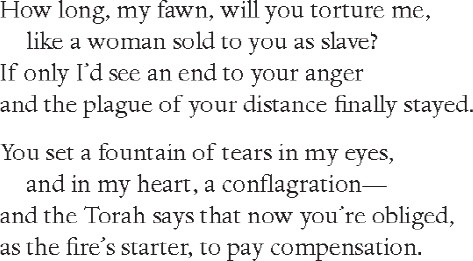
CURSES’ COMPOSITION
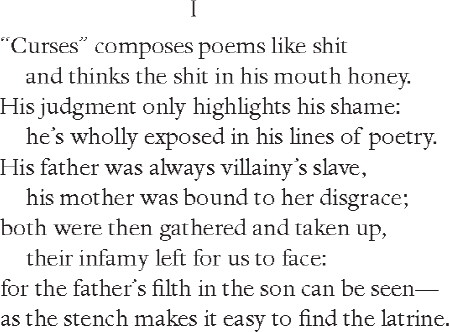

A FLASHING SWORD

PALINDROME FOR A PATRON; OR, CAUTION: THIS DOOR SWINGS BOTH WAYS
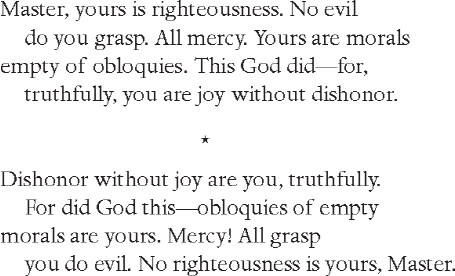
A POEM NO PATRON HAS EVER HEARD: WITH THE LETTER R IN EVERY WORD
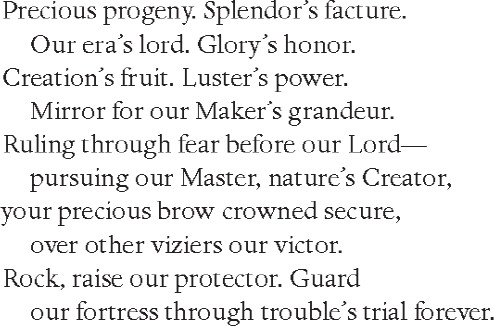
ADMIRATION FOR THE PATRON AGAIN I’LL PROVE, AND THE LETTER R I’LL NOW REMOVE
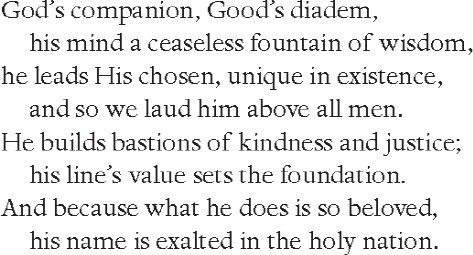
TWO POEMS ON KARAISM


II. AGAINST

VIRTUE

I’LL SET OUT A VERSE AND LAY THE FOUNDATION; THEN YOU’LL ADD ONE FOR THE STANZA’S COMPLETION
